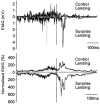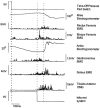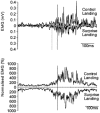Interaction of pre-programmed control and natural stretch reflexes in human landing movements
- PMID: 12411541
- PMCID: PMC2290625
- DOI: 10.1113/jphysiol.2002.024844
Interaction of pre-programmed control and natural stretch reflexes in human landing movements
Abstract
Pre-programmed mechanisms of motor control are known to influence the gain of artificially evoked stretch reflexes. However, their interaction with stretch reflexes evoked in the context of unimpeded natural movement is not understood. We used a landing movement, for which a stretch reflex is an integral part of the natural action, to test the hypothesis that unpredicted motor events increase stretch reflex gain. The unpredicted event occurred when a false floor, perceived to be solid, collapsed easily on impact, allowing the subjects to descend for a further 85 ms to a solid floor below. Spinal stretch reflexes were measured following solid floor contact. When subjects passed through the false floor en route to the solid floor, the amplitude of the EMG reflex activity was double that found in direct falls. This was not due to differences in joint rotations between these conditions. Descending pathways can modify H- and stretch-reflex gain in man. We therefore manipulated the time between the false and real floor contacts and hence the time available for transmission along these pathways. With 30 ms between floors, the enhancement of the reflex was extinguished, whereas with 50 ms between floors it reappeared. This excluded several mechanisms from being responsible for the doubling of the reflex EMG amplitude. It is argued that the enhanced response is due to the modulation of reflex gain at the spinal level by signals in descending pathways triggered by the false platform. The results suggest the future hypothesis that this trigger could be the absence of afferent signals expected at the time of false floor impact and that salient error signals produced from a comparison of expected and actual sensory events may be used to reset reflex gains.
Figures







Similar articles
-
Stretch reflex distinguished from pre-programmed muscle activations following landing impacts in man.J Physiol. 2000 Jul 15;526 Pt 2(Pt 2):457-68. doi: 10.1111/j.1469-7793.2000.t01-1-00457.x. J Physiol. 2000. PMID: 10896734 Free PMC article.
-
Modulation of short latency stretch reflexes during human hopping.Acta Physiol Scand. 1998 Jun;163(2):181-94. doi: 10.1046/j.1365-201X.1998.00351.x. Acta Physiol Scand. 1998. PMID: 9648637
-
Modulation of stretch reflexes during imposed walking movements of the human ankle.J Neurophysiol. 1999 Jun;81(6):2893-902. doi: 10.1152/jn.1999.81.6.2893. J Neurophysiol. 1999. PMID: 10368406
-
Contributions to the understanding of gait control.Dan Med J. 2014 Apr;61(4):B4823. Dan Med J. 2014. PMID: 24814597 Review.
-
The legacy of Gerald L. Gottlieb in human movement neuroscience.J Neurophysiol. 2022 Jul 1;128(1):148-159. doi: 10.1152/jn.00141.2022. Epub 2022 Jun 8. J Neurophysiol. 2022. PMID: 35675443 Review.
Cited by
-
The Anticipation of Gravity in Human Ballistic Movement.Front Physiol. 2021 Mar 17;12:614060. doi: 10.3389/fphys.2021.614060. eCollection 2021. Front Physiol. 2021. PMID: 33815134 Free PMC article.
-
Pre-activity modulation of lower extremity muscles within different types and heights of deep jump.J Sports Sci Med. 2008 Jun 1;7(2):269-78. eCollection 2008. J Sports Sci Med. 2008. PMID: 24149460 Free PMC article.
-
Postural control of sway dynamics on an unstable surface reduces similarity in activation patterns of synergistic lower leg muscles.Front Sports Act Living. 2025 Mar 12;7:1545813. doi: 10.3389/fspor.2025.1545813. eCollection 2025. Front Sports Act Living. 2025. PMID: 40144203 Free PMC article.
-
Control of dynamic foot-ground interactions in male and female soccer athletes: females exhibit reduced dexterity and higher limb stiffness during landing.J Biomech. 2014 Jan 22;47(2):512-7. doi: 10.1016/j.jbiomech.2013.10.038. Epub 2013 Nov 7. J Biomech. 2014. PMID: 24275440 Free PMC article.
-
Fast muscle responses to an unexpected foot-in-hole scenario, evoked in the context of prior knowledge of the potential perturbation.Exp Brain Res. 2010 Jun;203(2):437-46. doi: 10.1007/s00221-010-2248-9. Epub 2010 Apr 23. Exp Brain Res. 2010. PMID: 20414644
References
-
- Barnes WJP. Proprioceptive influences on motor output during walking in the crayfish. Journal of Physiology. 1977;73:543–564. Paris. - PubMed
-
- Bisdorff AR, Bronstein AM, Gresty MA, Wolsley C, Davies A, Young A. EMG-responses to sudden onset free fall. Acta Otolaryngologica: Supplementum. 1995;520:347–349. - PubMed
-
- Coulter JD. Sensory transmission through lemniscal pathway during voluntary movement in the cat. Journal of Neurophysiology. 1974;37:831–845. - PubMed
MeSH terms
LinkOut - more resources
Full Text Sources
Research Materials

